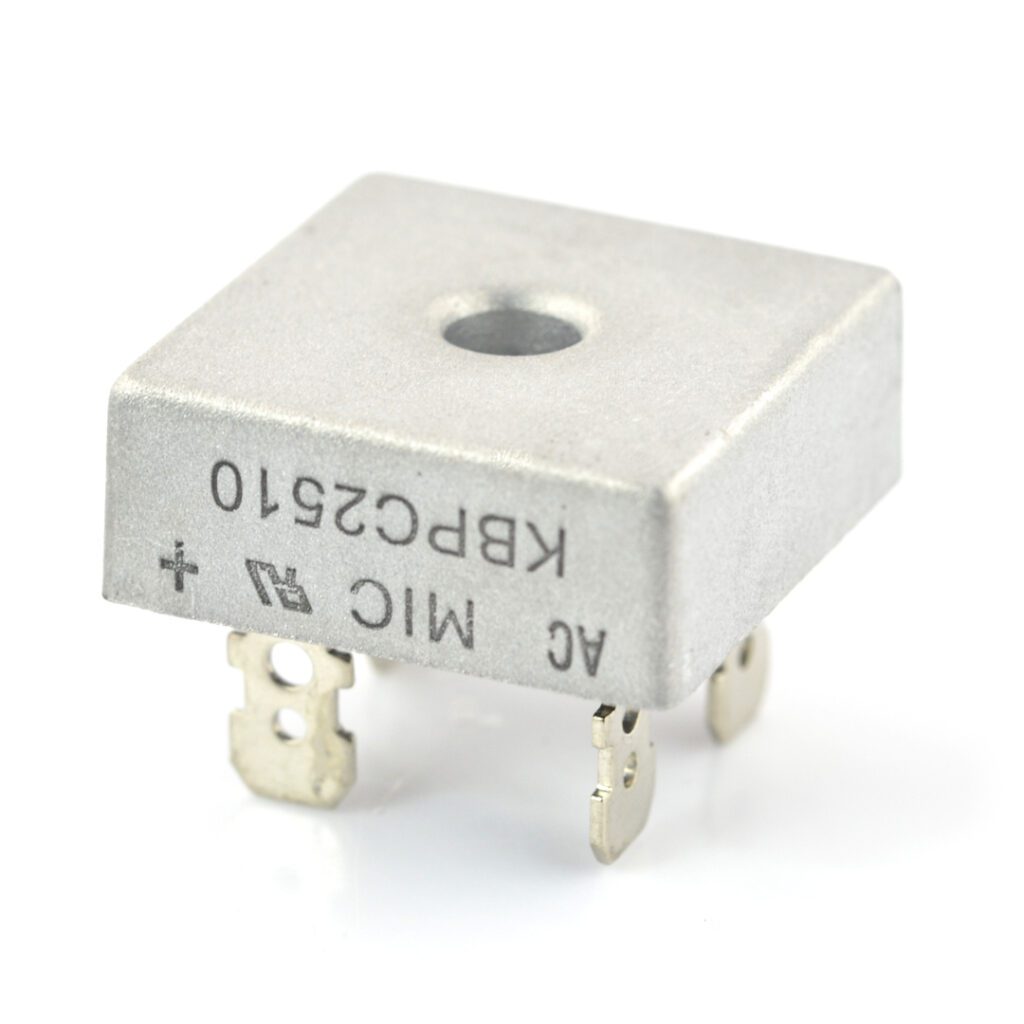Table of Contents:
Many mains-powered devices use alternating current (AC), but LED lights and battery-powered electronics, for example, require direct current (DC). Current conversion allows us to adjust the supplied energy to the needs of a particular device.
One way of doing this is provided by a Graetz rectifier bridge.
What is a Graetz system?
Think of the current flowing through a closed fed circuit as water pumped through a network of pipes from one tank to another. In this analogy, depending on the direction of flow of the pump, one tank will act as the inlet and the other as the outlet. The same thing would happen in a simple electrical circuit if the direction of the inlet current were reversed. Without a component acting as a transformer to provide the DC input, strange things would happen – for example, if a diode was connected to the circuit (in this comparison it could be a water wheel), it would start flashing as the direction of the current constantly changed. This illustrates quite well why many electronic devices need a DC power source to function properly.
A Graetz bridge, also known as a rectifier bridge circuit, is a type of circuit used to convert alternating current (AC) to direct current (DC). The circuit was invented by Karl Pollak and patented in December 1895 in the UK and January 1896 in Germany, but in 1897 Leo Graetz independently invented a similar circuit and published the result of his work. It is a popular rectifier circuit used in current power supplies, chargers, voltage regulating circuits and wherever AC to DC conversion is required. A prepared Graetz circuit consists of four diodes, which are connected in a bridge arrangement – hence these more common nomenclature. These diodes allow current to be conducted in both directions, making it possible to convert AC to DC.
How does a Graetz bridge (Graetz system) work?
During one half of the AC period, two diodes in the bridge are conductive and the other two are barrier. Current flows through the circuit through the two conducting diodes. During the other half of the AC period, the roles of the diodes are reversed. The diodes that were previously prohibitive become conductive, and the conductive diodes become prohibitive. Current flows through the circuit through two other diodes. In this way, the alternating current is converted to direct current because the current flows in the same direction through the circuit, regardless of the direction of the alternating current. The Graetz bridge thus provides an effective and efficient way to rectify AC current, making it a popular choice for many electronic applications. The simplicity of the design also features low power loss. Implementation remains straightforward, energy efficiency is high, and the versatility of applications extends from simple DC power supplies to sophisticated voltage regulation systems. That’s why we find Graetz bridges in power supplies for computers, televisions, chargers and emergency power systems.
Modern rectifier bridges
Modern rectifier bridge elements are small, compact and discrete semiconductor modules that can be manufactured at relatively low cost. In addition to being widely used in power supplies for electrical equipment, they are also very popular in general circuit design applications. They are usually divided into single-phase rectifier bridges or three-phase rectifier bridges , and further subdivided into uncontrolled, half-wave and fully controlled (full-wave) diode bridges. They can be found in a variety of mounting configurations and with popular options such as screw mounting, surface mount (SMD) or through-hole designs for PCB mounting (THT). Due to differences in the way they handle incoming AC signals, there is a noticeable difference in overall operating performance (output voltage) between different types of bridges, and this leads us to the question of criteria for a sensible choice in view of the desired application.
Choosing a Graetz bridge - what to look for?
The choice depends on the speed, efficiency and controllability requirements of the circuit. Equally important is the design space when facing the installation of additional components on the board. However, this is a matter of course. Make sure the rectifier bridge has sufficient current and voltage characteristics to handle the anticipated load. Consider both peak and average current and voltage. It is best to choose models with the lowest possible power loss to increase the efficiency of the overall system. An adequate operating temperature range will prevent overheating and ensure stable operation in a variety of environmental conditions. If the bridge uses rectifier diodes, check their parameters, such as switching speed, voltage drop (VF), and bandwidth in counteracting reverse polarity.
Full-wave rectification occurs when a diode bridge actively converts the negative component of the input AC voltage into a positive voltage, and then rectifies the entire resulting signal into direct current (pulsed current). This task is performed by two power diodes in a full-wave rectifier, one for each half-wave. Half-wave rectification, on the other hand, takes a different approach to the first step. Instead of converting the negative voltage component, a half-wave rectifier uses a single diode to simply remove it completely before the rest of the bridge circuit converts the remaining half of the signal into a usable DC input. This means that full-wave rectifiers are more efficient than half-wave rectifiers because the entire input waveform is converted and used to power the rest of the circuit. This usually also results in a lower ripple voltage than can be observed with a half-wave bridge rectifier circuit. Clear descriptions of the technical parameters of integrated circuits and rectifier bridges can be found in Botland.
How useful was this post?
Click on a star to rate it!
Average rating 5 / 5. Vote count: 2
No votes so far! Be the first to rate this post.




















